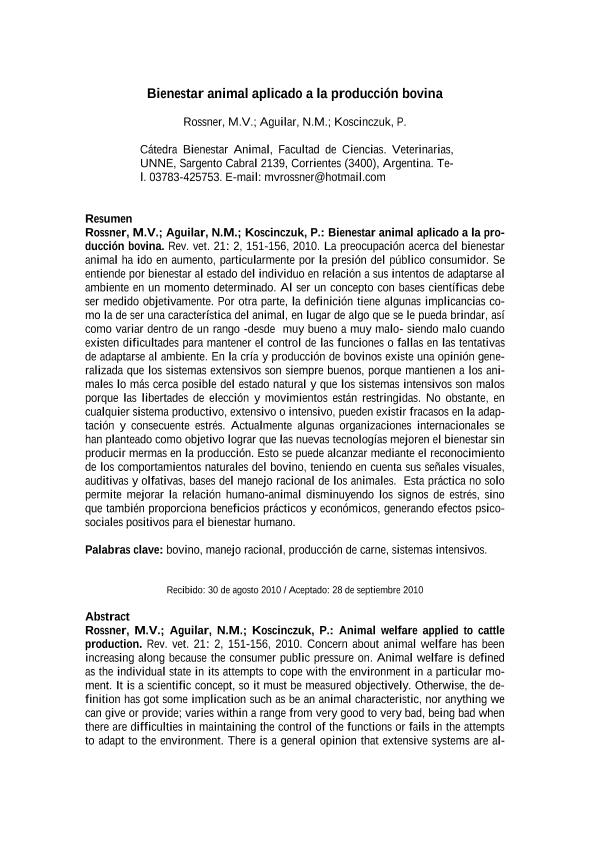Mostrar el registro sencillo del ítem
dc.contributor.author
Rossner, Maria Victoria

dc.contributor.author
Aguilar, Natalia Maria Alejandra

dc.contributor.author
Koscinczuk, Patricia

dc.date.available
2018-08-29T20:02:42Z
dc.date.issued
2010-11
dc.identifier.citation
Rossner, Maria Victoria; Aguilar, Natalia Maria Alejandra; Koscinczuk, Patricia; Bienestar animal aplicado a la producción bovina; Universidad Nacional del Nordeste. Facultad de Ciencias Veterinarias; Revista Veterinaria; 21; 2; 11-2010; 151-156
dc.identifier.issn
1668-4834
dc.identifier.uri
http://hdl.handle.net/11336/57582
dc.description.abstract
La preocupación acerca del bienestar animal ha ido en aumento, particularmente por la presión del público consumidor. Se entiende por bienestar al estado del individuo en relación a sus intentos de adaptarse al ambiente en un momento determinado. Al ser un concepto con bases científicas debe ser medido objetivamente. Por otra parte, la definición tiene algunas implicancias como la de ser una característica del animal, en lugar de algo que se le pueda brindar, así como variar dentro de un rango –desde muy bueno a muy malo– siendo malo cuando existen dificultades para mantener el control de las funciones o fallas en las tentativas de adaptarse al ambiente. En la cría y producción de bovinos existe una opinión generalizada que los sistemas extensivos son siempre buenos, porque mantienen a los animales lo más cerca posible del estado natural y que los sistemas intensivos son malos porque las libertades de elección y movimientos están restringidas. No obstante, en cualquier sistema productivo, extensivo o intensivo, pueden existir fracasos en la adaptación y consecuente estrés. Actualmente algunas organizaciones internacionales se han planteado como objetivo lograr que las nuevas tecnologías mejoren el bienestar sin producir mermas en la producción. Esto se puede alcanzar mediante el reconocimiento de los comportamientos naturales del bovino, teniendo en cuenta sus señales visuales, auditivas y olfativas, bases del manejo racional de los animales. Esta práctica no solo permite mejorar la relación humano–animal disminuyendo los signos de estrés, sino que también proporciona beneficios prácticos y económicos, generando efectos psicosociales positivos para el bienestar humano.
dc.description.abstract
Concern about animal welfare has been increasing along because the consumer public pressure on. Animal welfare is defined as the individual state in its attempts to cope with the environment in a particular moment. It is a scientific concept, so it must be measured objectively. Otherwise, the definition has got some implication such as be an animal characteristic, nor anything we can give or provide; varies within a range from very good to very bad, being bad when there are difficulties in maintaining the control of the functions or fails in the attempts to adapt to the environment. There is a general opinion that extensive systems are always good because they allow animals to keep as close as possible to the natural state, and intensive systems are bad because freedom of choice and movement are restricted. But in any production system, extensive or intensive, may be failures in adaptation that produce stress. Actually, some global organizations appoint to new technologies that improve animal welfare without causing production loss. This can be reached by means of recognition of the natural behavior of cattle taking into account the visual, auditory and olfactory signals, the baseline of rational handling. This practice not only improves the human animal relationship decreasing stress but also provide practical and economical benefits generating psychosocial positive effects for human welfare.
dc.format
application/pdf
dc.language.iso
spa
dc.publisher
Universidad Nacional del Nordeste. Facultad de Ciencias Veterinarias
dc.rights
info:eu-repo/semantics/openAccess
dc.rights.uri
https://creativecommons.org/licenses/by-nc-sa/2.5/ar/
dc.subject
Bovino
dc.subject
Manejo Racional
dc.subject
Producción de Carne
dc.subject
Sistemas Intensivos
dc.subject.classification
Otras Producción Animal y Lechería

dc.subject.classification
Producción Animal y Lechería

dc.subject.classification
CIENCIAS AGRÍCOLAS

dc.title
Bienestar animal aplicado a la producción bovina
dc.title
Animal welfare applied to cattle production
dc.type
info:eu-repo/semantics/article
dc.type
info:ar-repo/semantics/artículo
dc.type
info:eu-repo/semantics/publishedVersion
dc.date.updated
2018-08-17T19:00:56Z
dc.identifier.eissn
1669-6840
dc.journal.volume
21
dc.journal.number
2
dc.journal.pagination
151-156
dc.journal.pais
Argentina

dc.journal.ciudad
Corrientes
dc.description.fil
Fil: Rossner, Maria Victoria. Consejo Nacional de Investigaciones Científicas y Técnicas. Centro Científico Tecnológico Conicet - Nordeste; Argentina. Universidad Nacional del Nordeste. Facultad de Ciencias Veterinarias; Argentina
dc.description.fil
Fil: Aguilar, Natalia Maria Alejandra. Universidad Nacional del Nordeste. Facultad de Ciencias Veterinarias; Argentina
dc.description.fil
Fil: Koscinczuk, Patricia. Universidad Nacional del Nordeste. Facultad de Ciencias Veterinarias; Argentina
dc.journal.title
Revista Veterinaria
dc.relation.alternativeid
info:eu-repo/semantics/altIdentifier/url/http://revistas.unne.edu.ar/index.php/vet/article/viewFile/1948/1696
Archivos asociados
